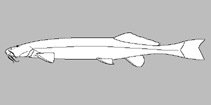http://www.fishbase.org/Summary/speciesSummary.php?genusname=Trichomycterus&speciesname=catamarcensis ---> http://192.134.151.83/Summary/speciesSummary.php?genusname=Trichomycterus&speciesname=catamarcensis
http://192.134.151.83/Summary/speciesSummary.php?genusname=Trichomycterus&speciesname=catamarcensis ---> https://fishbase.mnhn.fr/Summary/speciesSummary.php?genusname=Trichomycterus&speciesname=catamarcensis
https://fishbase.mnhn.fr/Summary/speciesSummary.php?genusname=Trichomycterus&speciesname=catamarcensis ---> https://fishbase.mnhn.fr/summary/Trichomycterus-catamarcensis.html
Trichomycterus catamarcensis

You can
sponsor
this page
Common name (e.g. trout)
Genus + Species (e.g. Gadus morhua)
-

-
About this page
-
Languages
-
User feedbacks
-
Citation
-
Uploads
-
Related species
-


 Upload your
photos
and
videos
Upload your
photos
and
videos
Google image
 No image available for this species;
No image available for this species;
drawing shows typical species in Trichomycteridae.
Classification / Names
Common names
|
Synonyms
| Catalog of Fishes(
genus
,
species
) |
ITIS
|
CoL
|
WoRMS
|
Cloffa
Teleostei (teleosts) >
Siluriformes
(Catfishes) >
Trichomycteridae
(Pencil or parasitic catfishes) > Trichomycterinae
Etymology:
Trichomycterus:
Greek, thrix = hair + Greek, mykter, -eros = nose (Ref.
45335
)
.
More on authors:
Fern√°ndez
&
Vari
.
Environment: milieu / climate zone / depth range / distribution range
Ecology
Freshwater; benthopelagic. High altitude; 26°S - 27°S
South America: Laguna Blanca basin in Catamarca, Argentina.
Size / Weight / Age
Maturity: L
m
?
range ? - ? cm
Max length : 4.2 cm male/unsexed; (Ref.
39970
)
Short description
Morphology
|
Morphometrics
Dorsal
spines
(total): 0;
Dorsal
soft rays
(total): 12-13;
Anal
spines
: 0;
Anal
soft rays
: 11 - 12;
Vertebrae
: 37 - 39. Eye covered by thin, transparent skin. Species differs from all other known members of the subfamily Trichomycterinae by the combination of its lack of both the pelvic fins and girdle, eight or nine principle dorsal fin rays, 37-39 vertebrae, 18-20 ribs on each side, the elongate body with a transversely flattened caudal peduncle, the posteriorly straight and slightly posterodorsally angled caudal fin margin, the lack of pronounced marmorated pigmentation on the body and fins, its lack of s very thick, rugose layer of fatty tissue on the body and head, the presence of a portion of the laterosensory canal system within the sphenotic, the lack of an extensive perforation of the skin surface by pores of the ampullary organs, and its maximum length.
Collected from a 0.5 m deep, small, clear water stream with a sandy bottom at an elevation of approximately 3500 m. The stomachs of two specimens contained dipteran larvae (Chironomidae and Ceratopogonidae), filamentous algae, and sand indicating that the species feeds, at least in part on autochthonous benthic macroinvertebrates (Ref.
37038
).
Life cycle and mating behavior
Maturity
|
Reproduction
|
Spawning
|
Eggs
|
Fecundity
|
Larvae
Fern√°ndez, L. and R.P. Vari
, 2000. New species of
Trichomycterus
(Teleostei: Siluriformes: Trichomycteridae) lacking a pelvic fin and girdle from the Andes of Argentina. Copeia 2000(4):990-996. (Ref.
37038
)
IUCN Red List Status (Ref.
130435
)
Least Concern (LC)
; Date assessed:
01 November 2020
CITES
Not Evaluated
Not Evaluated
Threat to humans
Harmless
Human uses
FAO - Publication:
search
|
FishSource
|
More information
Countries
FAO areas
Ecosystems
Occurrences
Introductions
Stocks
Ecology
Diet
Food items
Food consumption
Ration
Common names
Synonyms
Metabolism
Predators
Ecotoxicology
Reproduction
Maturity
Spawning
Spawning aggregation
Fecundity
Eggs
Egg development
Age/Size
Growth
Length-weight
Length-length
Length-frequencies
Morphometrics
Morphology
Larvae
Larval dynamics
Recruitment
Abundance
BRUVS
References
Aquaculture
Aquaculture profile
Strains
Genetics
Electrophoreses
Heritability
Diseases
Processing
Nutrients
Mass conversion
Collaborators
Pictures
Stamps, Coins Misc.
Sounds
Ciguatera
Speed
Swim. type
Gill area
Otoliths
Brains
Vision
Tools
E-book
|
Field guide
|
Length-frequency wizard
|
Life-history tool
|
Point map
|
Classification Tree
|
Catch-MSY
|
Special reports
Check for Aquarium maintenance
|
Check for Species Fact Sheets
|
Check for Aquaculture Fact Sheets
Download XML
Summary page
|
Point data
|
Common names
|
Photos
Internet sources
AFORO (otoliths) |
Aquatic Commons
|
BHL
|
Cloffa
|
BOLDSystems
|
Websites from users
|
Check FishWatcher
|
CISTI
|
Catalog of Fishes
:
genus
,
species
|
DiscoverLife
|
ECOTOX
| FAO - Publication:
search
|
Faunafri
| Fishipedia |
Fishtrace
| GenBank:
genome
,
nucleotide
|
GloBI
|
Google Books
|
Google Scholar
|
Google
| IGFA World Record |
MitoFish
|
Otolith Atlas of Taiwan Fishes
|
PubMed
| Reef Life Survey | Socotra Atlas |
Tree of Life
| Wikipedia:
Go
,
Search
| World Records Freshwater Fishing |
Zoobank
|
Zoological Record
Estimates based on models
Phylogenetic diversity index (Ref.
82804
): PD
50
= 0.5000 [Uniqueness, from 0.5 = low to 2.0 = high].
Bayesian length-weight: a=0.00851 (0.00355 - 0.02043), b=2.93 (2.74 - 3.12), in cm total length, based on LWR estimates for this Genus-body shape (Ref.
93245
).
Trophic level (Ref.
69278
): 2.8 ±0.31 se; based on food items.
Resilience (Ref.
120179
): Low, minimum population doubling time 4.5 - 14 years (Assuming Fec < 100).
Fishing Vulnerability (Ref.
59153
): Low vulnerability (10 of 100).
Back to Search
Random Species
Back to Top
Accessed through:
Not available
FishBase mirror site :
localhost
Page last modified by :
mrius-barile
- 20 July 2016
Fatal error
: Uncaught ArgumentCountError: Too few arguments to function checkEcotox(), 1 passed in /var/www/html/summary/speciessummary.php on line 2304 and exactly 3 expected in /var/www/html/includes/speciessummary.lib.php:2579 Stack trace: #0 /var/www/html/summary/speciessummary.php(2304): checkEcotox() #1 {main} thrown in
/var/www/html/includes/speciessummary.lib.php
on line
2579
|